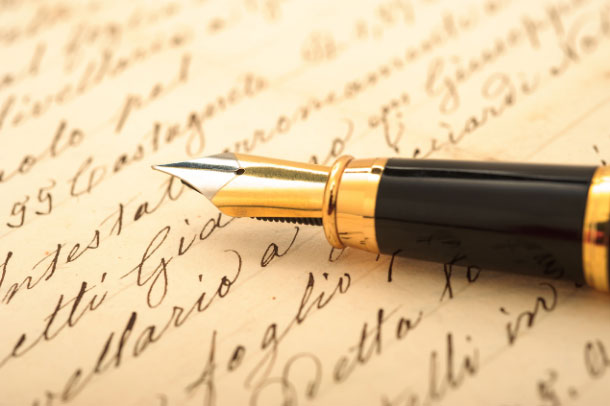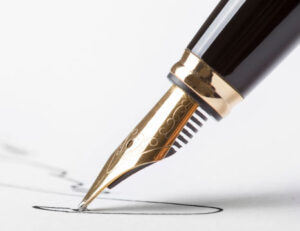Your cart is currently empty!
What Is A Fountain Pen?

Introduction
The best fountain pens have always combined memorable styling with superb writing qualities. A properly tuned and customized fountain pen can provide the user with an unsurpassed writing experience.
Replacing quills and dip pens, fountain pens were first introduced in the late 19th century. Fountain pens innovated by containing their own internal ink reservoir, which eliminated the need for an ever-present ink bottle.
Fountain pens remained the writing instrument of choice through the mid-20th century, when inexpensive ballpoints gained a larger market share. Fountain pens retained their popularity in Europe and Japan, however. Meanwhile, advances in design and engineering helped adapt fountain pen manufacture to contemporary needs and styles.
In the last decades of the 20th century a revival of interest in the fountain pen began that has continued to this day. The ease of use of contemporary fountain pens, combined with their greater expressiveness compared to ballpoints and rollerballs, has led to what many describe as a second “golden age” of fountain pen use and production.
Fountain Pen Nibs

At the heart of the fountain pen is the nib, a slender piece of metal with a small vertical slit. This nib is most often made of 14k, 18k, or 21k solid gold, which provides for a durable writing point that can last for a lifetime and more.
Other precious metals, such as palladium or titanium, are occasionally used for fountain pen nibs. These nibs can usually be given the same tuning and many of the same customizations as solid gold nibs.
Less expensive pens are most often provided with a stainless steel nib. Steel nib can corrode over time, and do not have the same suitability for tuning and customization as do solid gold nibs.
Nib Tuning and Customization
Nib tuning, also known as nib set-up or optimization, is a process by which the pen and its nib are tested to ensure proper functionality. The pen and nib are then adjusted to the writing characteristics and preferences of the individual user.
Nib tuning was once a common part of the pen-buying process. PacificPenWorks.com is now one of the few fountain pen retailers to offer this service, which is complimentary with the purchase of any pen or nib from us.
Nib customization takes this process further by actually regrinding or otherwise altering the nib to provide for more expressive writing on the page. Special customizations for calligraphy, signatures, and scribal forms of writing are also available.
Nib tuning and nib customizations are highly skilled tasks performed by trained nib specialists. At PacificPenWorks.com, we’re proud to have this work done for our customers by Mike Masuyama and John Mottishaw.
With their many years of experience, Mike and John are two of the most well-known and highly respected nib specialists in the field. They are also responsible for having pioneered many of the customizations we now offer.
Pen Body and Materials
As important as the nib for many users is the material used for the fountain pen itself. Most contemporary pens are produced using high quality resins, including handcrafted cellulose acetate for some higher end models.
Celluloid was the material of choice for high quality fountain pens during the 1930’s and 40’s. Handcrafted celluloid is still used for special writing instruments by some European and Japanese manufacturers.
For many enthusiasts, however, hard rubber ebonite remains the quintessential pen material. Often produced with natural rubber harvested from the rubber gum tree, ebonite is a durable and versatile material. Like solid gold nibs, ebonite body pens can last a lifetime and more.
Pen bodies usually consists of a separate cap and barrel which thread or snap together when the pen is not in use. The gripping section is the forward part of the barrel where the user holds the pen.
The clip is a usually metal piece attached to the side of the cap, devised originally for allowing the pen to be clipped to a shirt pocket. But clips also serve as a built-in roll-stopper to prevent your favorite pen from rolling off a desk and onto the floor!
Filling Systems
Fountain pens are provided with a variety of filling systems, with most contemporary pens utilizing either a cartridge-converter or piston-fill system.
Cartridge-converter filling systems tend to be the easiest to use for beginners or just anyone who prefers their convenience. Cartridge-converter pens can use either disposable ink cartridges, or a refillable converter that can be filled with any bottled fountain pen ink.
Piston-fill systems, on the other hand, have a built-in mechanism allowing ink to be drawn up directly from the bottle and into an internal reservoir inside the pen. Piston-fill pens often have a higher ink capacity than cartridge-converter pens, allowing for longer periods of uninterrupted writing.
Other filling systems include vacuum or power fillers, which function similarly to a piston-filler. Eyedropper fillers, as the name implies, must be hand-filled with an eyedropper or plastic syringe, and tend to have the highest ink capacities of any contemporary fountain pens.
Fountain Pen Inks
Fountain pen inks are specially formulated to flow easily in the feed that leads from the cartridge or reservoir to the nib. Some inks are known as particularly “wet” and free-flowing, others as “dryer” and fast-drying on the page.
Many different companies produce fountain pen ink. Choosing an ink produced by a fountain pen manufacturer ensures that you are using a conventionally-formulated ink which should be safe to use with any contemporary or vintage pen.
Which Pen To Choose
Fountain pens can be affordable on any budget. Options range from simple steel nib pens for under $50 to finely crafted Maki-e pens which can cost thousands of dollars. A good starting point for first time users are introductory-level gold nib pens, which start at around the $140 level and up.
Whatever writing style you use, and whatever style and design most appeals to you, there will be a pen for you. Have questions? Whether you’re new to the world of fountain pens, or a longtime experienced user and collector, we’re happy to be of help.
Just contact us at info@nibs.com – we’ll be happy to guide you through the process of selecting a new fountain pen, whether it’s your first, or your one hundred and first. We’ll be looking forward to hearing from you…
